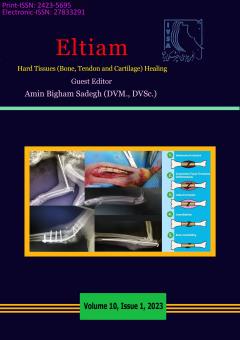patellar luxation in dogs
Subject Areas : Veterinary Soft and Hard Tissue Surgery
Alireza Shaikhzadeh
1
*
,
Amin Bigham-Sadegh
2
![]()
1 - resident, department of clinical science, faculty of veterinary medicine, Shiraz university, Shiraz, Iran
2 - professor, department of clinical science, faculty of veterinary medicine, Shiraz university, Shiraz, Iran
Keywords: medial patellar luxation, lateral patellar luxation, stifle, pelvic limb, dog, small breeds, canine,
Abstract :
Patellar luxation is a common orthopedic problem in dogs. Both large and small breed dogs may be affected; the disease may be seen in cats as well. Medial luxation is more common than lateral luxation and is usually diagnosed in dogs of small breed. patellar luxation based on severity of occurred changes divided to 4 different grades. Patellar luxation is a congenital/developmental disorder, but it could be secondary to traumatic accident causing tearing or stretching of the joint capsule and fascia, leading to femoropatellar instability. Diagnosis is based on clinical evidence of patellar instability; however, diagnostic imaging is required to assess the amount of skeletal deformity and then the most appropriate method of treatment. Clinical signs of dogs with patellar luxation can vary from animal to animal and are only partially related to the degree of concomitant skeletal deformities. Lameness may be intermittent or continuous, and usually is a mild-to-moderate weight bearing lameness with occasional lifting of the limb. Concurrent rupture of the CrCL has been reported in a study in 41% of the stifle joints of dogs with medial patellar luxation. Surgical options include both soft tissue and osseous techniques, however, in most of the cases, a combination of more procedures is used to achieve the correction of the luxation. Complication rate is generally low and the most common complications include reluxation and implant-associated complications. Prognosis is generally favorable, with most of the dogs returning to normal limb function. This article describes patellar luxation features in dogs, including clinical presentation, diagnosis, and treatment options available
1. Nunamaker DM. Textbook of Small Animal Orthopaedics. Lippincott Williams & Wilkins; 1985.
2.Abercromby RH, May C, Turner BM, Carmichael S, Ness MG. A Survey of Orthopaedic Conditions in Small Animal Veterinary Practice in Britain. Veterinary and Comparative Orthopaedics and Traumatology. 1996;9(2):43-2.
3. DeAngelis M. Patellar Luxation in Dogs. Veterinary Clinics of North America. 1971;1(3):403-15.
4. Linney WR, Hammer DL, Shott S. Surgical treatment of medial patellar luxation without femoral trochlear groove deepening procedures in dogs: 91 cases (1998–2009). Journal of the American Veterinary Medical Association. 2011;238(9):1168-72.
5. Roush JK. Canine Patellar Luxation. Veterinary Clinics of North America: Small Animal Practice. 1993;23(4):855-68.
6. Bosio F, Bufalari A, Peirone B, Petazzoni M, Vezzoni A. Prevalence, treatment and outcome of patellar luxation in dogs in Italy. Veterinary and Comparative Orthopaedics and Traumatology. 2017;30(5):364-70.
7. Alam MR, Lee JI, Kang HS, Kim IS, Park SY, Lee KC, Kim NS. Frequency and distribution of patellar luxation in dogs. Veterinary and Comparative Orthopaedics and Traumatology. 2007;20(1):59-4.
8. LaFond E, Breur GJ, Austin CC. Breed Susceptibility for Developmental Orthopedic Diseases in Dogs. Journal of the American Animal Hospital Association. 2002;38(5):467-7.
9. L’Eplattenier H, Montavon P. Patellar luxation in dogs and cats: management and prevention. Compendium. 2002;24(4):292-300.
10. Dona FD, Della Valle G, Balestriere C, Lamagna B, Meomartino L, Napoleone G, Lamagna F, Fatone G. Lateral patellar luxation in nine small breed dogs. Open Veterinary Journal. 2017;6(3):255.
11. Harasen G. Patellar luxation: pathogenesis and surgical correction. The Canadian Veterinary Journal. 2006;47(10):1037.
12. Priester WA. Sex, size, and breed as risk factors in canine patellar dislocation. Journal of the American Veterinary Medical Association. 1972;160(5):740-2.
13. Alam MR, Lee JI, Kang HS, et al. Frequency and distribution of patellar luxation in dogs. 134 cases (2000 to 2005). Vet Comp Orthop Traumatol. 2007;20(1):59–64.
14. O’Neill DG, Meeson RL, Sheridan A, Church DB, Brodbelt DC. The epidemiology of patellar luxation in dogs attending primary-care veterinary practices in England. Canine Genetics and Epidemiology. 2016;3(1).
15. 1 Vidoni B, Sommerfeld-Stur I, Eisenmenger E. Diagnostic and genetic aspects of patellar luxation in small and miniature breed dogs in Austria. Companion Animal Practice. 2006;16:149.

